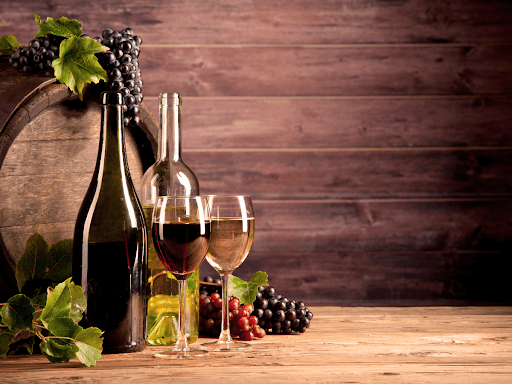There’s red wine and white wine. Even if you were the greenest of wine novices, you must know that much. However, did you know some wines seem like a cross between red and white wines, and there are wines with a touch of spirit? You may also not know it, but champagne (with a lowercase c) differs from Champagne (with an uppercase C).
So, before you buy champagne online, read this guide and learn about the six different types of wines.
Table of Contents
1. White Wine
White wines are wines made from clear grape juice. They are usually made using green-skinned grapes (or so-called white grapes). However, they can also be made using purple-skinned or red-skinned grapes (so-called black grapes). In the latter’s case, the white wine produced is known as a blanc de noir — i.e., white from black.
White wines are commonly varietal wines — i.e., made from a single grape variety. However, there are also white wine blends. Chardonnay, Sauvignon Blanc, Riesling, and Chenin Blanc are light-skinned grapes often used to make white wines. Pinot Grigio is a dark-skinned grape often used to make white wine.
White wines are clear-coloured or transparent only because the winemaker immediately removed the grape skins and stems after juice extraction. In other words, the minimal contact between the juice and the coloured skins makes white wine colourless.
Colourless is not strictly true, either. White wines typically have a hint of colour. They can be greenish, yellow or golden; aged whites can even be pale brown.
2. Red Wine
Red wines are dark-coloured wines made from dark-coloured (purple, red or black) grapes. While you can make white wine from black grapes, you cannot make red wine using only green-skinned or white grapes. It is the dark-coloured skins that give red wines their colour.
To make red wine, the winemaker crushes the grapes, and the juice is allowed to remain with the grape skins and seeds (and stems, too, if the winemaker wants to ferment grapes in clusters). This process is called maceration, which can occur before, during, and even after fermentation. It is during maceration that the juice acquires the colour of the grape skins (as well as the flavour compounds present in them).
Red wine can be ruby-, purple-, or garnet-hued, and they can be blends or varietals. Syrah and Barolo grapes are varietal wine favourites. Bordeaux, the red blend from the Bordeaux wine region in France, is typically made from Cabernet Sauvignon, Merlot, Cabernet Franc, Malbec, Petit Verdot, and Carménère. Tempranillo, Syrah, Sangiovese, Garnacha, Graciano, Gamay, and Zinfandel are also used to make red wine.
Rosé Wine
Rosé is French for pink, which is fitting because rosé wine is pink wine.
The most common method of making rosé wine is through short-term maceration. It is the same process used to make red wine, except the juice is exposed to grape skins only for a relatively short time (a few hours to a few days) when making rosé. The quicker the juice is exposed to the skins, the more delicate the wine’s colour (and red-fruit flavour) is.
The direct press method is another way to make rosé wines. This is the same method used to make white wine — i.e., the winemaker presses the grapes and immediately separates the juice from the skins. However, some dark-coloured skins naturally come away with the liquid, giving the resulting wine its delicate colour and light flavour.
Rosé wine may also be created by adding some red wine to base white wine, but this is not a standard method and is used only in making rosé d’assemblage Champagne or blended pink Champagne.
3. Sparkling Wine
Sparkling wines are fizzy and bubbly wines. They can be red, white or pink, and they can be varietals or blends. You can say they’re carbonated wines; the carbon dioxide that makes soda fizz is the same gas that gives sparkling wines their bubbles.
Champagne (note the capital letter C) from the Champagne region in France is one of the most notable sparkling wines. Aside from Champagne, Prosecco (Italian sparkling wine) and Cava (Spanish sparkling wine) are also well-known sparkling wines.
Note: You can only call sparkling wine Champagne if it hails from the Champagne region. Therefore, there is no such thing as (a lowercase c) champagne.
However, when Champagne became the golden standard for sparkling wines and before France moved to protect its Champagne designation, makers of sparkling wines everywhere called their products champagnes.
The Chicago Manual of Style encourages everyone to use “sparkling wines” to refer to sparkling wines that are not from the Champagne region. However, it admits that using champagne to refer to sparkling wine is a widely accepted practice.
4. Dessert Wines
Dessert wines refer to sweet wines. They often accompany or follow dessert.
To make this highly sweet wine, winemakers use different approaches. For instance, winemakers can harvest grapes late to concentrate the grapes’ sugar content (e.g., a late harvest Sauvignon Blanc). Others infect their grapes with botrytis cinerea or noble rot to create wines with intense dried fruit and honeyed flavours. Finally, some let the grapes freeze on the vine. The winemaker then presses the frozen grapes, extracting juice with highly concentrated sugar content.
5. Fortified Wines
Fortified wines are often lumped with dessert wines because sweet fortified wines make great after-meal or dessert wines. However, not all fortified wines are sweet. They are also made differently from dessert wines.
Fortified wines are wines fortified with spirits during fermentation. This gives them higher alcohol by volume content (around 17-20%) than regular wines.
Popular fortified wines include Port, Madeira, Sherry, and Marsala.
Choose Your Wine
There are six types of wines: white, red, rosé, sparkling, dessert, and fortified. Now that you know the basics, you can be more confident requesting the wine menu and ordering wine the next time you’re in your favourite Dubai restaurant.

